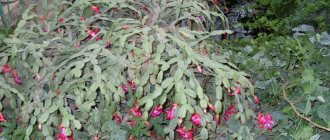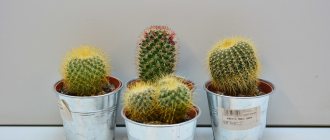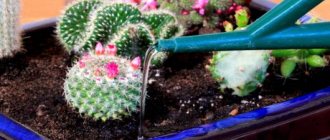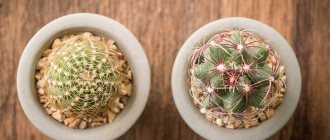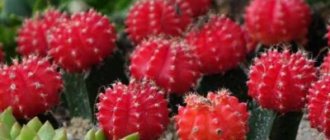Cactus is a perennial plant from the Carnation family. It comes from North and South America, from the islands of the West Indies. You can also meet it in Africa, in Madagascar. Some representatives of cacti are distributed throughout the continent, except Antarctica. In Russia, some plant species are common on the coasts of Crimea, the Mediterranean Sea, the south of the Volga region and other places.
Cactus is a unique representative of evergreen plants. There are more than 3,000 plant species. Cacti reach a height of 10 meters and live on average 500 years. It is covered with thorns and thorns up to 12 centimeters long. There is a waxy coating and hairs all over the trunk. The plant has no leaves, and consists of a thick, green stem of various shapes. They can be smooth or ribbed, it all depends on the type of plant. There is only one type of cactus, the Pyrexia, which has leaves similar to those of citrus plants.
The plant grows in the sands of deserts, from rock crevices, under the open scorching sun. Cactus tends to accumulate water in its cells. In deserts, for example, the temperature during the day is very high, but at night it drops to 10 degrees, and this drop causes dew to form. It settles on plants and soil. This amount of moisture is enough for them to survive. Abundantly moist soil is detrimental to the plant, the root system rots, and the cactus begins to wither.
The cactus blooms very rarely, but it is a flower of unusual beauty and aroma. Many plant species produce fruits that are used as livestock feed. Cacti are also used to make hedges. The trunks are used in the construction of dwellings.
In addition to wild cacti, there are cultivated domestic ones. They are grown on windowsills in pots. You can buy soil at the store specifically designed for cactus plants. Minimal care required. They need to sunbathe for at least 4 hours, and the soil should be moderately moist. You need to water it with rain or melt water, you can also pour tap water into a bottle and let it settle for several days. Also, during the summer, the cactus can be planted in open ground.
Almost no one knows that cactus absorbs solar radiation. It is also used in medicine. In the 20th century it was discovered that it contains an antibiotic. With its help, many diseases are cured.
Cactus is an amazing and mysterious flower.
Option 2
Cactus is a perennial flowering plant. The cactus belongs to the carnation family. Cacti are divided into four groups:
- The first group includes the Pereskiev subfamily. This is a type of shrub that has its own leaves and stems. This subfamily of plants is considered a transitional link between cacti and deciduous plants.
- The second group includes the Opuntiaceae subfamily. These plants have leaves, stems, and also thorns - glochidia. This type of spikes is special. These are very small and hard spines, which, when they get into the stomach of an animal that has eaten them, cause a very strong burning sensation and irritation, thereby protecting itself from being eaten.
- The third group includes the subfamily Maukhienivyh. These plants are very similar in appearance to the Opuntiaceae subfamily. The difference is that this subgroup does not have spines - glochidia.
- The fourth group includes a subfamily called Cactaceae. These plants do not have leaves or glochidia. The shape of the plant is usually always a ball or a cylinder. Some species are shaped like flat leaves.
Cacti have very wide uses by people. They are used in food, medicine, as paints, and as a building material. These plants are specially grown as hedges. Cacti are widely used as indoor plants in our apartments and offices.
Cacti are a favorite delicacy in Mexico. They are called dragon fruits. Edible varieties of these plants are grilled with onions and tomatoes, and various salads, desserts, jams and soups are prepared. Strong alcoholic drinks, such as tequila, are made from cacti.
The appearance of cacti is very interesting, so they are widely used as an ornamental plant. Another positive aspect of cacti is that they are very unpretentious in everyday life - they rarely need to be watered. They are resistant to heat and dry air, and are unpretentious in reproduction.
The cactus is especially good when it blooms. The flowers of this plant are white, pink and scarlet. These flowers have a very pleasant aroma, which is why cacti are also used in cosmetology to create perfumes, tonic creams and gels.
Bloom, my star!
Cacti may not bloom at all if there are no suitable conditions for this. Some species begin to bloom from the age of three, while others will take as long as 10 years. Flowering of the cactus usually begins in the spring, after a period of dormancy. It is quite difficult to achieve flowering of a plant, and suitable conditions for them are not always sufficient.
It is necessary to alternate the life stages that are observed in the natural growth conditions of the cactus. Therefore, if you want a cactus to bloom, you need to choose one of two ways: either make every effort to achieve the desired result, or choose unpretentious species.
Message about Cactus
Cacti evolved from other perennial plant species more than 30 million years ago. The word “cactus” is of ancient Greek origin, but its meaning has not reached our days. Many experts believe that this word was coined by Carl Linnaeus and means a plant with thorns. America is the birthplace of cacti. Now some of their species are distributed throughout the world, not counting Antarctica. They also grow in Russia: on the Black Sea coast and in the south of the Volga region.
There are cacti of all sizes and shapes. They can be spherical, creeping, columnar. The specific structure of the plant helps it escape from drought. The cactus can withstand temperatures up to 60 degrees. They range from two centimeters in diameter to 2-3 tons in weight. Instead of leaves, cacti grow spines. They differ in size and location. Some species have soft spines, while other species have hard ones. They are necessary for the plant to protect itself from animals. Wolves and dogs are especially afraid of them.
Flowers of cacti can be of different colors and shades. This depends on its species, as well as the type of pollination. The main pollinators of cacti are hummingbirds, bees and all kinds of butterflies.
Even before Columbus arrived in America, local residents used cacti for various purposes: they ate them for food, made strong hedges from them, and extracted dyes. And they were even used as medicine and a drug for ritual activities. Some types of cacti are still used for food by Mexicans. They prepare candied pieces from them, which are considered the best delicacy for the local population. In Argentina, drums are still made from cactus trunks. The plant is a good raw material for making soap and shampoos, vitamins and various sweets, as well as alcoholic beverages. Twenty-meter tall Californian cacti called cereus have more than once saved travelers from thirst, as they contain more than 2 tons of drinking water.
Cacti, as an ornamental plant, attracted many Europeans for their unusual appearance. They began to be grown in Europe in the 16th century. Many cactus lovers have collected entire collections. One of these famous collectors was Morgan, a London pharmacist. Large collections were presented in the botanical gardens of Moscow and St. Petersburg, and in private greenhouses. In Russia, cacti began to be grown as indoor plants in the 50s of the 20th century.
You can find many popular science publications and dictionaries about cacti, but there is still no complete reference book in Russian.
Several interesting essays
In the story of Maxim Gorky, Old Woman Izergil, a vivid example of love for people and self-sacrifice is the legend of Danko. The work itself is filled with deep meaning, like most of the works of this author.
The epic story “Ilya Muromets and the Nightingale the Robber” describes the wishes of the people regarding the need for a defender of the weak from the misfortunes of the enemy. This was Ilya-Muromets, who defeated the evil and formidable
All school subjects can be compared to the bricks that make up our general education. They are equally important elements of this education, and it is impossible, giving preference to one, not to engage in others at all
One of the interesting genres of literature for children is the classic Russian folk tale. These tales contain witchcraft, magical transformations, miracles, and adventures.
Green hedgehogs, which can often be found on the windowsills of flower growers and housewives, bloom in a variety of colors, each with its own character and whimsicality, and that’s all about them. about cacti. Cacti are native to dry deserts and steppes. Botanists count about 3,000 species of this plant. Different types of cacti have unexpected, bizarre shapes: round and ribbed balls, cakes, and columns. All cacti are covered with spines of various colors and sizes.
The most amazing thing about these green creatures is the amazing resilience with which they withstand heat and lack of moisture. They can live for many years even in a sealed flask with moist soil. When these prickly creatures bloom, it is difficult to find more beautiful flowers than their flowers. Some bloom once every five or even more years, some annually, and last for six months.
Echinocactus contains about 80% water in its pulp, which is comparable to watermelon or cucumber. Donkeys learned to extract water from it by knocking down the top layer of the plant along with the thorns with their hooves.
The fruits of some cacti are edible; they are very large, juicy and tasty. The yellow and red fruits look like a pear covered with small thorns. There are cacti that taste like strawberries and are used to make soft drinks. Various delicacies are made from cacti, their fruits are sold in markets, Indian tribes use it as medicine and also as a drug to enter a stupefying state for rituals. Cactus fruits are eaten raw, jams and compotes, unusual-tasting creams and jams are made from them, they are added to wine for color and aroma, and stewed with meat in the form of a stew.
Twenty species of cacti are an excellent antibiotic that can cure some complex diseases. Aphids are bred on cacti, from which food coloring is obtained.
Growing and collecting cacti is a very exciting area of modern floriculture. Collectors understand complex names and sophisticated agricultural techniques. It happens that completely different cacti are called by the same name. There is still no reference book for cactus growers with a description of all types and varieties in Russian. Cactus lovers still use the old German reference book by Kurt Beneberg and Walter Hage, or small reference books with the main species.
Conflicting opinions arise regarding the fact that the cactus protects PC users from harmful radioactive radiation generated by the monitor. Many adherents of a healthy lifestyle place cacti around the apartment to protect against radiation and even carry pocket cacti with them to protect against mobile radiation. The opposite opinion suggests that its imaginary usefulness of protection from radioactive radiation was imposed back in Soviet times. Cacti do grow better in conditions of increased electromagnetic radiation, but the idea that the plant absorbs radiation is highly controversial. However, the spines still serve as an air ionizer, this is a proven fact.
So, nature lovers, a beautiful blooming thorny garden on your window is not only a room decoration, a source of creative work and care, but also a useful plant in all its manifestations.
Popular messages and reports today
This chronicle is an early source describing the history of Rus'. Here is information relating to the Middle Ages. It is this story that helps modern scientists reconstruct events
Interesting insects are cockroaches. An order of arthropod parasites that are very common in the world.
Chamomile is a perennial flowering plant that is known to every person since childhood. The most common type of this flower is called chamomile.
The continent is located in the Western Hemisphere, or more precisely in the north of the Western Hemisphere. It is washed by three oceans at the same time.
A.S. Pushkin is a poet whose name is known not only in Russia, but also far beyond its borders. His work is a tremendous wealth of all world literature, and his biography is replete with many
Almost every nation has its own national instrument. When we mention bagpipes, we imagine the Scots, the harmonica – the Germans, and the dombra – the Kazakhs. National instrument of the Russian people
The cactus is an unusual plant that differs from others in the absence of leaves and the presence of spines. Photosynthesis occurs with the help of the green pillar of which it is composed. The way this plant does not resemble more than one leafy plant, biologists and sailors who often visited America became interested in it.
The shapes and sizes of cacti are very diverse, they can be both tall and low, both thin and thick, both round and oval. In the wild, cacti are large and branchy, and they grow wildly. But at home, they are small in size and always well-groomed, and usually such plants do not have branches; they can appear in several decades.
The spines of a cactus perform an important function; since this plant has a poorly developed root system, the cactus can only take moisture with the help of the spines. So, the main function of the thorns is to absorb moisture. The spines also perform a protective function; they protect the plant from sunlight and temperature changes, especially when it gets dark and colder.
A small cactus should not feel a lack of water, so you need to look at the soil; if the soil is dry, then it’s time to water it. An adult cactus needs to be watered about four times a month in the summer, but in winter it does not need watering at all, and if watering is necessary, then no more than twice a month.
When watering your plant, you should pay attention to its location; if the pot is on the sunny side, then it needs to be watered often, and if it is in the shade, then it needs to be watered less often.
Regular tap water is not suitable for watering your prickly friend, because it is cold and rich in chlorine, which can have a detrimental effect on the plant. It is recommended to boil 5 liters. water and add 9% vinegar there, this is a good food for cactus.
In the desert, cacti are a real salvation for people, because they quench thirst and hunger, and this plant is also useful for eating. By the way, candied fruits are made from cacti, jam is made, wines, liqueurs and the well-known tequila are made.
Cactus is a unique plant that has won the hearts of not only scientists, but also ordinary people, because this plant is not only beautiful in appearance, it has many benefits and is used in the food industry.
Reproduction and transplantation
The usual instructions for growing cacti cannot do without mentioning transplants. Adult plants can develop in the same soil for up to 3 years in a row. When it comes time to replant them, tongs are usually used, but some gardeners prefer to simply wear thick mittens. Please note: in the last 5 days before transplanting, the earthen ball should not be watered. If the plant has already bloomed, it cannot be moved to new land.
It is very important to choose the right pot. It is not advisable to rush into replanting, even in cases where roots appear from the drainage holes. It is likely that from this moment the plant will accumulate green mass for some time.
If the specimen has formed deep roots, the container should be narrow but high. Wide flowerpots are used for varieties that produce a significant number of children. A drainage layer must be placed at the very bottom:
- expanded clay;
- rolled river pebbles;
- brick;
- polystyrene foam (but it is not practical).
It is very important to ensure that the soil is laid out tightly - to do this, while filling it is necessary to sometimes knock on the walls of the pot. When the soil is laid, you can immediately plant the cactus, but you cannot bury it. The soil layer should be 0.01 m below the edge of the container. The remaining gap is filled with shells or small stones. The easiest way to propagate a cactus is with children and cuttings. If children do not form on a certain species, cuttings are recommended.
Vaccinations are carried out in the spring or in June, when growth is rapid by the standards of succulents. Seeds are sown in January and February, but seed propagation is very difficult and risky.
It is strictly forbidden to use nutrient soil. In it, seedlings can rot or suffer from mold. At least 50% of the planting mixture should be sand, which is pre-disinfected. It is up to the growers themselves to decide whether to heat it or treat it with boiling water.
Option 2
Cactus is a perennial flowering plant belonging to the Carnationaceae group. Plants evolved about 30 million years ago, at which time they acquired their familiar appearance. The habitat of cacti is the countries of the New World. They are widespread in North and South America, as well as in the West Indies. They are found in Africa, on the island of Madagascar and in Sri Lanka, where they were brought by migratory birds. Since the cactus is a very unpretentious plant, today it can be found on all continents in botanical gardens or in private collections of indoor plant lovers.
In Greek culture, the word “kaktos” denoted plant species unknown to scientists. Later, Carl Lineus began to use this word to classify cacti.
Plants of the cactus family come in different shapes (from spherical to cone-shaped and elongated). They grow in desert areas. The cactus root system consists of two parts: surface roots and roots that go deep into the ground. The climatic conditions of deserts create large temperature differences, due to which moisture falls in the form of dew. Surface roots, whose length reaches 5 meters, collect this moisture, allowing the plant to survive for a long time without watering or rain.
The second type of roots holds massive cacti above the ground. This root has an impressive size, so even during hurricanes the plants do not suffer from gusty winds. However, it does not reach groundwater and therefore mainly serves only as an “anchor”.
The stem of a cactus is capable of absorbing water. It can be ribbed or smooth. Depending on the type of cactus, bristles, spines or leaves are formed on its surface. They are modified bud scales of stem tissues. The large cactus flower has a pleasant aroma. It contains areoles in the form of spines and hairs.
People have been using the fruits and stems of the cactus for food since ancient times. Used as a medicinal product. It also serves as a building material and hedge. Dwarf cactus species are grown in homes as an ornamental plant.
Blossfeldia is the smallest species
The smallest species of cacti grows in South America - Blossfeldia , named after the botanist Harry Blossfeld. It can be found in Bolivia and Southern Argentina, on the slopes of the Andes.
This is a miniature cactus, the diameter of which is 1-3 cm, without tubercles of ribs. It has no thorns and is woolly. The flowers grow on the top of the cactus, last 205 days, they are also small, up to 1 cm in diameter.
Message 3
Planet Earth is known for its diversity of plants, which have their own characteristics and unusual features. One of the most popular and unusual flowering plants is the cactus family. Scientists and botanists are trying to determine the time of formation of cacti, although no fossil remains have been found, but presumably they have been growing on earth 30 million years ago.
The etymology of the word is known only because in ancient Greek it was the name of another plant, which is now unknown to science. Since 1771, cacti began to designate green plants whose surface is covered with spines. Even earlier they were called melocactus, and then this name was simply shortened.
The origin of cacti comes from South and parts of North America. Migratory birds brought cactus seeds to Africa and Asia. Later, people began to spread the plant around the world. Now the cactus tends to grow in any part of the world except Antarctica. Undoubtedly, the cactus prefers warm places, because its homeland is the desert, where there is a minimum of moisture and maximum sun. In Russia, cacti are found in the south, in Crimea and the region of the city of Gelendzhik.
Not all cacti are similar in structure and are closely related. The main cactus family has a special organ - the halo. It resembles a kidney. The fruit and flower of a cactus are part of a stem, which is not typical of other plants. The areoles resemble spines in appearance and the hairs are also called buds, since they collect moisture from the space and are able to retain it inside for a long time in order to preserve life. In this case, the fetus does not have needles.
Section 5. Cactus: coloring book for children
And at the end of the article for the youngest readers - coloring pages of cacti! Color and create your beautiful cactus garden in a picture - an applique, a postcard or in an album.
Download coloring pages for children “Cacti”
More about cacti: interesting ideas, exciting materials for games and activities with children can be found in the articles of “Native Path”:
— “Craft for children: blooming cactus Princess of the Night.” A story for children about an unusual cactus and a step-by-step master class
— Poems about cactus for children: 23 poems for toddlers, preschoolers and schoolchildren, as well as humorous poems about cactus with tasks for children. — Riddles about cacti for children: 23 riddles for preschool and primary school children about cacti. Riddles from simple to the most complex.
Report about Cactus
One of the plants that lives in dry places is the cactus. This is a prickly plant belonging to the cactus family. Unpretentious in care, they grow on the sands of deserts, semi-deserts and rocky plateaus. The spines located throughout the plant are modified leaves. They come in various lengths and shapes. With their help, plants manage to remain for a long time without water under the scorching sun. They store moisture and release it for a very long time, since the stomata that were located on the leaves have become smaller due to the change in shape into spines. They also serve to protect against animals.
The stem of a cactus can have different shapes: columnar, spherical, cylindrical and others.
The uses of cacti are quite wide and varied. Some, when flowering, produce edible fruits for humans, and some are used as livestock feed. Large cacti are sometimes used as hedges, and some trunks are used for construction.
For many years, cacti have been used as house plants. After all, they are not fussy to care for. Some cacti sprout flowers of various shapes and colors. Cacti were brought to Europe from America. They attracted people with their unusual appearance. Many people collect entire collections of decorative cacti on their windowsills at home. Entire greenhouses with different types of cacti are being created.
As mentioned earlier, cacti are unpretentious in care. The temperature in which they can live depends entirely on the light. The more light a plant receives, the more heat it needs. This explains the fact that cacti can grow in deserts. Accordingly, if the plant receives little light, then it will require less heat. Therefore, at night, the room temperature should not exceed 18 degrees Celsius. Although cacti are adapted to life in arid places and can remain without moisture for a long time, still, like any living creature, a cactus requires water. From which he will receive all the substances necessary for existence. The amount of water depends on the life activity of the cactus. During the period of activity, the cactus requires a sufficient amount of water so that the substrate under it does not dry out. During dormancy, reduce watering to a minimum. In summer, watering is once every 1-3 weeks. Watering should be carried out after the soil has completely dried. In autumn and winter, water the indoor plant with one tablespoon of water every 8-10 days. Plants can also obtain moisture from the air with the help of spines.
Some species can grow for hundreds of years
Home cacti live from 10 to 50 years, but in nature they can live up to 100 years or longer. Thus, the Stenocereus tubera cactus lives up to 150 years . Its other name is organ pipe. An adult plant grows up to 7-8 m, its period of greatest growth is from April to June. Only when it becomes an adult does the cactus bloom. The fruits taste like watermelon. Considered a rare species.
Another long-lived cactus is Pachycereus Pringle, which does not die until 200 years old. It can grow up to 20 m. In spring it is covered with flowers, with white petals. The cactus blooms for 4-5 weeks. The fruits are reddish and contain narcotic substances.
Message 5 option
Cactus is a plant that lives primarily in tropical climates. It is distinguished by the presence of spines and the absence of leaves. Most cacti are so different from the plants we are used to that sometimes we are even surprised to see something in front of us that looks more like an alien creature. It is worth saying that cacti are in many ways similar to ordinary plants. They have the same organs as everyone else.
There is an opinion that almost all cacti grow in deserts. But this is not entirely true. Cacti grow extremely slowly, and as soon as they appeared on the surface, they would immediately be covered with sand. But deserts are different, with different annual precipitation and temperatures. There is no place on earth where only cacti grow. If we see a cactus somewhere, it means that many other plants can be found nearby. Most cacti grow in semi-deserts, tropics and steppes.
Growing a cactus at home is quite a simple task. If they can grow in the desert, then a flower pot will seem like paradise to them. However, it is worth understanding that the cactus also needs proper care. Yes, cacti can live for a long time without water, especially in winter, but, nevertheless, sometimes it is worth watering them. Cacti should be placed on window sills or on the balcony. Many people place a cactus next to their computer, thinking that this plant will help them get rid of some harmful radiation. But this is not true.
The cactus can also be used for medicinal purposes. Cactus juice has an antibacterial effect and also helps against rheumatism. According to many scientists, cactus can be used to treat headaches, stomach problems, and pieces of cactus can also be applied to a wound for speedy healing. An ordinary plant, but so many benefits! Cacti can be completely different. Their stems can be round, elongated, ribbed, etc. Not all cacti may have spines; there are also absolutely “naked” representatives. If you got a cactus with spines, then you need to be very careful with it. After all, one wrong move, and you already have a thorn sticking out of your finger, which will be very painful to get back.
If the owner of the cactus is lucky, he can observe a beautiful flowering. Flowers can be of completely different sizes, but they will certainly be beautiful and have eye-catching shades. Different cacti bloom at different times. Some can bloom almost every month, while others have to wait for years.
If you are planning to bring a cactus into your home, then you should understand that they rarely get along with other indoor plants. The point here is the conditions of detention. For example, a large number of plants require special humidity, while for a cactus this will only cause harm and suffering.
Also, do not water cacti with regular tap water. Such water is usually hard, which causes a large amount of salts to accumulate at the base of the stems, which harms the plant. In order for the cactus to feel good and please its owner for many years, it should be watered with rain or melt water. You should also use special soil, which can be purchased at garden stores.
Conditions of detention
It would take a long time to describe the nuances of the structure of cacti and their varieties. But much more important is the information that will allow you to cultivate this plant at home. Yes, they are unpretentious, and a succulent can “just survive” almost anywhere. However, the real challenge for gardeners and flower growers is the flowering of cacti. It's quite difficult to achieve. The specifics of the content greatly depend on the specific species.
Forest varieties can develop successfully in partial shade, and even in dense shade. But all other cacti at home can only be grown in bright light. It is impossible to avoid deformation of the trunk unless you systematically turn it around, exposing a new side to the sun.
Important: cacti only welcome temperature changes. Unlike the vast majority of plants, this situation is quite natural for them. During the summer months, the prickly succulent should be kept at high temperatures and low humidity. In the cold season, the air should be heated to a maximum of 14-16 degrees. Overwintering in warm rooms blocks flowering.
You can safely buy soil for cacti from the store, but some people prepare it themselves. For this purpose mix:
- washed river sand;
- leaf soil;
- charcoal;
- a small amount of peat.
Form the mixture so that it is as loose as possible. Low acidity is optimal. It is absolutely forbidden to add clay - in its raw form it interferes with the normal breathing of the roots. If the clay dries out, it will crack and can damage the roots purely mechanically.
Report cactus indoor plant
Cacti are one of the most ancient plants on our planet. They appeared on Earth many, many years ago, when dinosaurs still lived on the planet.
These plants have a trunk of various shapes - there are round ones, similar to hedgehogs. And there are straight ribbed trunks. All cacti have one thing in common: instead of leaves, most of them have spines. The spines can be small and located throughout the trunk of the plant, or they can be sparsely located, but larger in size. Some types of cacti simply have very large spines, which can easily injure a person or animal. The needles of these plants serve for protection from damage by animals and for reproduction: the spines are attached to the fur of animals or clothing of people and are transported over long distances.
People use different types of cacti in different ways. There are cacti - medicinal plants. Large tree-like cacti are used as hedges. Cacti are also used as ornamental plants - indoors, greenhouses, or to create beautiful compositions in flower beds.
Low species of cacti are used as indoor plants. With favorable care, indoor cacti bloom with beautiful delicate flowers. Some types of cacti bloom exclusively in the dark and for only a few hours. Lovers of indoor cacti collect them in collections all over the world, exchange them, and develop new varieties.
In nature, cacti grow only in warm and sunny climates - in America, Africa, and India. Cacti are not afraid of prolonged drought, as these plants can accumulate water in their trunks during the rainy season. In the open air, some species of cacti grow to the size of huge trees or grow in the form of large, spiny pillars.
Cactus is a very beautiful and unusual plant.
About 3,000 species of cacti
Carl Linnaeus was the first to classify the cactus family. But gradually botanists learned about new genera and species of cacti, and new classifications appeared.
Now, according to different classifications, there are different numbers of species - from 1750 to 5 thousand . There are many classification systems, including those from the German botanist Carl Schumann, from the Americans N. Britton and N.J. Rose, from the Austrian F. Buxbaum, from the German Kurt Backeberg. It is the latter that enjoys special trust.
Popular reports
The most famous and interesting works are considered to be the fables of Ivan Andreevich Krylov. Having gone through a long and difficult creative path of misunderstanding and indifference, the great writer was able to reach the high level to which he had strived all his life.
In the very center of the Eurasian continent, an amazing lake called Baikal was able to form. The lake is surrounded on all sides by majestic mountain ranges. Its size amazes not only visiting tourists, but also many local residents.
The word "metal" comes from the Greek word for "spear". Accordingly, metals are extracted from the earth in the form of minerals. First, it is necessary to obtain ores, from which metals are then extracted. Mining is carried out in two ways: open or
- Author: Maria Sukhorukikh
Rate this article:
- 5
- 4
- 3
- 2
- 1
(0 votes, average: 0 out of 5)
Share with your friends!
Diseases and pests
The impressive endurance of cacti does not mean that they are completely protected from infections and various pests. Moreover, it is often impossible to recognize the real problem without expensive examinations. Important: the rarer a particular species is, the more valuable it is considered, the higher the risk of problems. The only way to really do anything is to comply with containment conditions as scrupulously as possible. It is enough to allow the slightest deviation and serious diseases will arise.
The biggest threat is rot. If the roots are rotting, it can be assumed that the cactus is simply reacting to unfavorable conditions. This condition most often manifests itself in long-term inhibited growth. At the same time, the stem may dry out, and even increased watering does not help. When the rot is not too severe, replanting partially healthy plants can help. Additionally, it is worth subjecting the cactus to a hot bath.
You should not throw away the plant, even if the root system is almost completely degraded. The earthen lump is thoroughly washed in hot water, then the dead tissue is removed, even if only the root collar remains. Important: the cut should be made only with sterilized instruments, and the cut points will also have to be disinfected.
Much worse is wet stem rot. This disease develops much faster, and is noticed only in the later stages. Rotten tissue is cut off completely. Disinfection is carried out very carefully. The plant can be restored if the damage is minor. Of course, if a lot of tissue is cut, the surviving specimens will inevitably be mutilated. Therefore, it is better to get rid of cacti that are not valuable enough.
If a particular plant is very important, you can use side shoots or surviving remains. Dry rot cannot be cured. But you can periodically treat the plant with fungicides, then the disease will be prevented.
Spotting can be the result of infection by microbes or viruses. These microorganisms infect mainly specimens that have suffered from unfavorable conditions. The appearance of the spots can vary greatly in shape, color and depth. There is no point in removing stains. To prevent the spread of spotting, it is necessary to spray still healthy specimens with fungicides. But a much better result comes from eliminating the causes of the disease.
How to determine age?
It is impossible to determine the age of a cactus visually. There are only two options to find out: track it from the moment of sowing or ask the person who grew it. The age of a cactus is calculated by dormant periods. If, for example, a cactus grows for three years in the same conditions - from humidity to lighting, then all three years are one year of the cactus’s life.
How long a cactus grows depends, first of all, on the species. Some species can reach several meters in height with a properly selected pot. But in any case, it is easier for wild cacti to reach maximum height than for domestic ones. The famous “Queen of the Night” can reach 20 m in height.
Diseases
Diseases of cacti are most often caused by bacteria, lower fungi, mycoplasmas, and viruses. Their impact can lead to the death of the plant, and rare and valuable species most often become targets of enemies. To avoid infection of cacti, favorable living conditions will again help.
Among cactus diseases, the most common are:
- spotting;
- viral mosaic of epiphyllums;
- Euphorbia mosaic virus;
- jaundice;
- prickly pear witches' brooms;
- dry and wet rot;
- mushroom growth and others.
You can learn about diseases and pests of cacti here.
Cacti, like any plants, require careful care , care and special conditions. Sometimes you need to take care of house flowers as if you were your own children, because it is the owner’s attitude towards the plants that determines their health, beauty and normal development.
